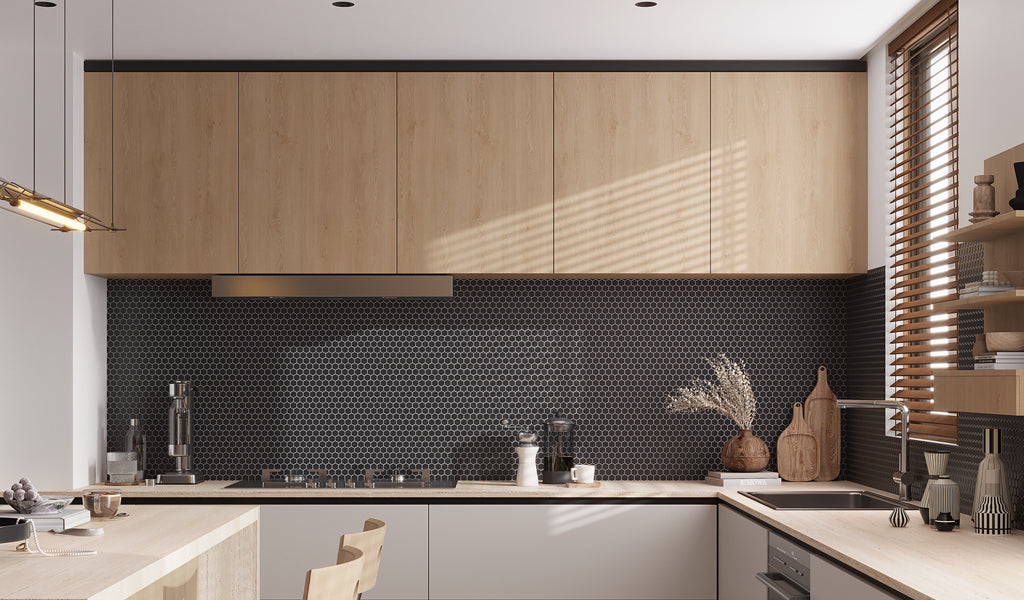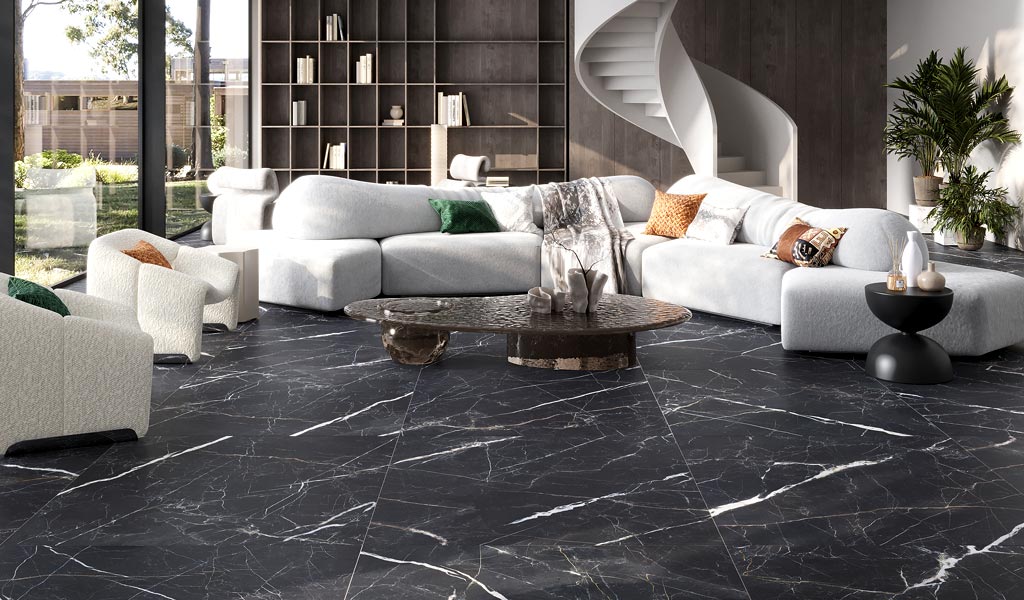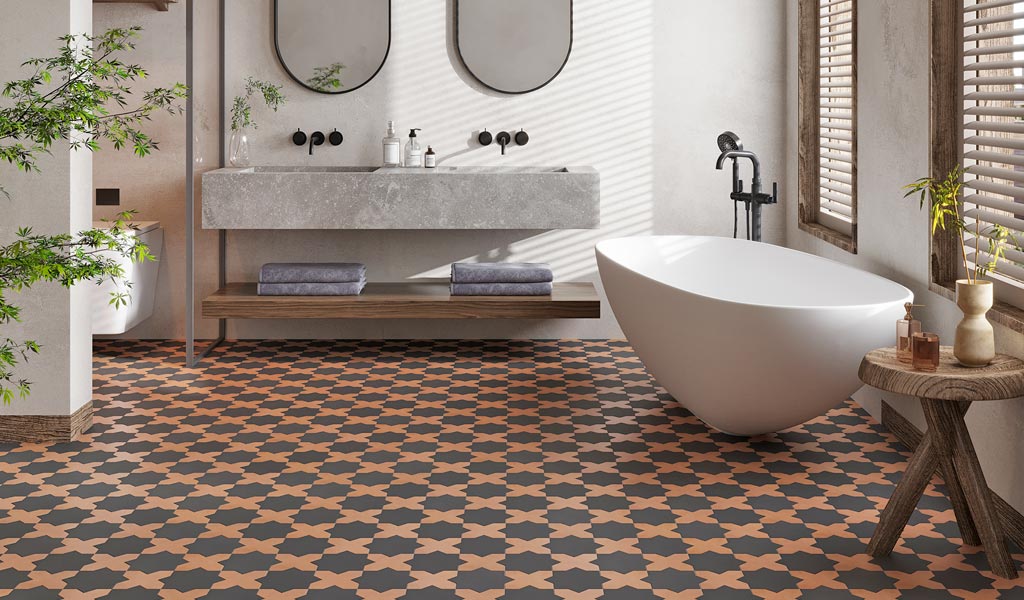Different types of tiles with their pros, cons, and applications.
Mar 27, 2023Tile is a popular choice for flooring, walls, and even some roof applications. There are a variety of types available, each with its own unique properties that can make it better suited to certain tasks. The various pros and cons of different tile materials should be considered when selecting the right one for your project.
This article will discuss the most commonly available types of tile, their pros and cons, and the applications they are best suited for. By understanding these different types of tile, the right choice can be made to achieve the desired look and functionality. Ready? Let’s dive in!

1. Pros, Cons and Applications of Porcelain Tiles
Likely not a surprise to hear, but porcelain tiles are a favorite in the design world. This type of tile is known for being low maintenance and thanks to printing advancements, truly versatile.
When it comes to identifying one of these tile types, here’s a little tip: Place a bit of water on the back. Does it stay in place? No absorption? That’s a porcelain tile for you!
Now for the pros and cons of this material.
The pros of porcelain tiles
Porcelain tiles are one of the most popular types due to their durability and style. They are incredibly strong, making them suitable for high traffic areas and can even hold up against freezing temperatures (hello, backyard decks and patios!).
Porcelain tiles also come in a variety of colors and textures thanks to the printing techniques used, allowing you to choose a tile that perfectly fits your decorating style. Moreover, they are easy to clean and maintain, making them a great choice for any home – especially ones with kids of pets. The last pro to keep in mind – and a favorite in this economy – is that porcelain tiles are often more affordable than other types of tile, so you can get the look you want without breaking the bank. Woo!
The cons of porcelain tiles
Now, let’s peek at the cons.
The cons of porcelain tiles include their hefty weight, which can make them difficult to install. Since they tend to be denser to make sure water isn’t absorbed, they can be heavier. You win some, you lose some.
Additionally, they are harder to cut than other types of tile, making installation even more challenging. This just means it may not be the best DIY beginner project, and a professional tiler should be consulted.
Alas, the final con consideration: Porcelain also has a slightly lower coefficient of friction than other materials, so it may not be the best choice for areas where slip protection is important.
So, where can I place porcelain tiles?
The good news is that you can place them almost anywhere thanks to their inherent strength.
Here are some inspirational ideas to get you started:
- Porcelain tiles can be used for kitchen countertops and flooring.
- Use them for bathroom walls, floors, or ceiling.
- Place them in outdoor areas like patios or walkways.
- Get creative with porcelain mosaic tile designs on your shower walls or in your entryway.
- Porcelain is also popular for fireplace surrounds.

2. Pros, Cons and Applications of Ceramic Tiles
Ceramic tiles are as timeless as can be. Dating back centuries, these types of tiles can be found on the streets of Portugal and covering European buildings. They are known for their natural beauty, and ease of installation.
Wondering if you found a ceramic tile? Plop a bit of water on the back, and if it's absorbs, that’s the one!
If you’re curious about what some of the pros and cons are, here is a breakdown of both.
The pros of ceramic tiles
First and foremost: Ceramic tiles are a great choice for any home due to their durability and style. Being a time-tested material, it is one of the most classics that you can choose from. Thanks to that, you can literally find hundreds of styles and colors that fit you.
Ceramic tiles are also known for their hypoallergenic nature. This ensures that there will be no dust or allergens that can irritate your family members. This is really great if anyone has sensitivities within the home. Plus, it is also water-resistant and highly stain-resistant, making them great for spaces such as kitchens, bathrooms, and patios (more on that later).
The cons of ceramic tiles
As gorgeous and versatile as ceramic tiles are, they are more prone to staining and cracking than porcelain counterparts. Additionally, they are not as heat resistant so they may not be suitable for areas with direct sunlight. This isn’t so much a con as a consideration when you place the tile. Know that in direct sunlight, over time, chips may occur. Aged beauty, if you will.
Furthermore, ceramic tiles can often be more expensive than other types of tile, making them a bit pricier, and grout lines are more visible on ceramic tiles than porcelain. This is a downside for those who would like a seamless look in their home, making this not the right choice.
Where do you place ceramic tiles?
Well, it’s best to install ceramic tiles in low-traffic locations that don’t get direct sunlight. They are beautiful and a great choice for backsplashes and bathroom showers, but not the best in high-traffic areas like hallways or kitchens. The softer surface of these tiles is more likely to be damaged underfoot.
Here’s a list of some places to use ceramic tile:
- Backsplash in the kitchen - One of the most classic, timeless options out there.
- Staircases - You can place right on the front of the steps. It will make an incredible first impression.
- Accent walls in the living room - Hello book nook! Make the space really pop.
- Fireplace surrounds - Yes, while not the most heat resistant, you can still place ceramic tiles superficially around the fireplace for an unforgettable aesthetic

3. Pros, Cons and Applications of Marble Tiles
Dating back to Roman times, marbles have always been associated with luxury and high esteem. Not much has changed today. These natural tiles are still known for their elegance.
How can you spot one? Well, we’re sure it’ll be obvious by looking at one (then again, new marble look tiles can make it hard). So, here’s a trick: Look at the veining and the back of the tile. These tiles won’t have a smooth back like porcelain or ceramic tiles. They will be the same front-to-back.
The pros of marbles tiles
Marble tiles are a great choice for adding an elegant, luxurious look to any room. They are strong and durable which makes them perfect for high-traffic areas such as kitchens and bathrooms. Additionally, marble tiles come in a variety of colors – nero marquina is a velvety black, norwegian rose is a pretty pink, for instance – and textures so you can customize the look of your space with ease.
One other thing to love? Marble tiles are heat resistant and can last for many years with proper cleaning and care. This means that marble tiles can retain their beauty over time, making them an excellent long-term investment!
The cons of marble tiles
The main downside of marble tiles is their cost. They are typically more expensive than other tile options, so they may not be ideal for those on a tight budget. Additionally, marble tiles can be prone to staining and etching unless they are properly sealed and maintained.
It should be noted that marble is a softer material than other stone options which means it can be more susceptible to scratch and chip damage. You should take care to maintain it properly and seal as needed.
Finally, while it’s perfectly okay to use marble tiles outside or in your entryways, these classic stone tiles can hold onto dirt and other debris which can make them harder to clean over time. Staying on top of sweeping is key!
Where can you place marble tiles?
- Kitchen floors
- Bathroom walls and countertops
- Entryway floors
- Fireplaces
4. Pros, Cons and Applications of Slate Tile

The pros of slate tiles
The pros of slate tiles include their cost, durability and appearance. Slate tiles are often less expensive than other stone options, making them a great choice for budget-conscious homeowners. Additionally, they are very durable and strong, making them an ideal option for high traffic areas like kitchens or bathrooms.
They also have a unique texture and come in a variety of colors and hues, making them a great choice for homeowners looking to create an impactful design.
One of the final perks? Slate tiles are low maintenance like some other options, as they require only regular cleaning and resealing. The resealing process helps protect the tiles from damage over time. This is why it’s such a great choice for outdoor patios. They really can withstand a whole lot.
The cons of slate tiles
The cons of slate tiles include their weight, porosity and difficulty of installation. Slate tiles can be extremely heavy, making them difficult to install and transport.
What’s more, they are quite porous, meaning that liquids can easily seep into the tile's surface. This can lead to staining or fading over time if proper sealing is not maintained.
You should also know that slate tiles can be difficult to install due to their weight and size, requiring specialized tools and knowledge in order to do so properly. This increases the cost of installation and can add difficulty for a DIY project.
Where can you place slate tile?
- Kitchen floors
- Bathroom walls and floors
- Outdoor patios and decks
- Fireplace surrounds
- Outdoor walkways
- Entryways or foyers
- Staircases
- Accent walls in kitchen or bathrooms
5. Pros, Cons and Applications of Glass Tile

The pros of glass tiles
The pros of glass tiles include their durability, ease of cleaning and maintenance, resistance to staining and water damage, and aesthetic appeal. Glass tile is a great option for areas where moisture is present because it is waterproof and resistant to mold growth.
Additionally, glass tile can be customized in different colors and patterns which provides a great deal of flexibility in terms of design and customization. Finally, glass tiles also require minimal maintenance because they do not need to be sealed or waxed. Thus, glass tile is a great choice for those looking for a long-lasting and low-maintenance option for their home.
The cons of glass tiles
The cons of glass tiles include their cost, difficulty of installation, and the fact that they can be slippery when wet. Glass tile is also prone to breakage if not installed properly and may require special tools for cutting and fitting.
Additionally, some types of glass tile are more susceptible to scratches than other materials like ceramic or stone. Finally, removing glass tile can be more difficult than other materials and may require professional assistance.
Where can glass tiles be used in the home?
- Glass tiles can be used in a variety of areas in the home, including bathrooms, kitchens, and even outdoor spaces.
- They can be used as flooring, wall coverings, backsplashes and countertops.
- Glass tile is also often found in pools and other water features due to its waterproof nature.
- Overall, glass tile is an attractive and durable option for many areas of the home.
6. Pros, Cons and Applications of Terrazzo Tile

The pros of terrazzo tiles
The pros of terrazzo tiles include their durability, aesthetic appeal, and affordability. Terrazzo is a long-lasting material that can add a unique look to any space. It is also relatively inexpensive compared to other materials like natural stone or ceramic tile.
This material is easy to clean and maintain as it only needs sweeping and occasional mopping. Unlike other materials, terrazzo is also non-porous so it won't absorb dirt or other debris making it a great choice for kitchens and bathrooms.
It is also available in a variety of colors and patterns to suit any design preference. Finally, it requires minimal upkeep as there is no need for sealing or waxing which makes terrazzo an excellent choice for those looking to add a long-lasting, stylish look to their home. With all of these benefits, terrazzo tiles are a great choice for any space.
P.S: You can also find terrazzo look porcelain tiles. All the beauty plus even more durability!
The cons of terrazzo tiles
Terrazzo tiles do have some drawbacks. The installation process is lengthy and can be difficult to install on your own without professional help. Additionally, the material is expensive which may make it out of reach for those working with a limited budget. Finally, terrazzo takes time to cure before sealers or coatings are applied and this curing time cannot be rushed. These cons should be taken into account when considering terrazzo tiles for your home. While the long-term benefits may make it worth the investment, it is important to weigh all of your options before making a decision.
Where can terrazzo tiles be placed in the home?
- Kitchen flooring or backsplashes
- Bathroom showers, walls, or floors
- Dining Room floors
- Patios, Decks and Outdoor Spaces
So, when it comes to choosing the right type of tile for your home, there are a variety of options available with its own set of pros and cons. It’s important to thoroughly understand and research each so you can choose the best fit for yourself!
Ready to shop for your perfect tile? Get started now.










